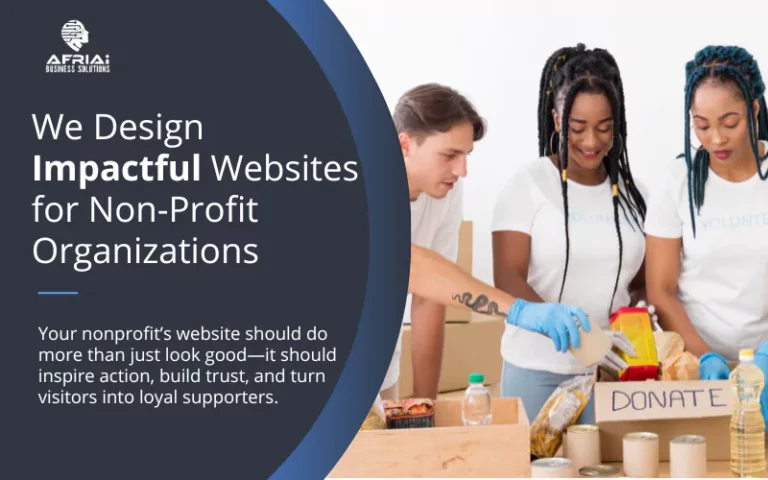I have a website now what?
Are you feeling overwhelmed with the task of managing a website? Are you unsure of what steps to take next? Fear not, for you are not alone. In today’s digital age, having a website is crucial for businesses and individuals alike, but knowing what to do with it can be daunting. Let us guide you through the perplexing world of website management.
What Is A Website?
A website is a collection of related web pages that contain various types of content, such as text, images, videos, or applications. These pages are hosted on a web server and can be accessed via a network, typically the internet. A website serves as a platform for individuals, businesses, or organizations to showcase information, products, or services to a global audience. It can be either static, displaying fixed content, or dynamic, with interactive elements for user engagement. Additionally, a website can support e-commerce, blogs, forums, and more, catering to diverse purposes.
Understanding ‘what is a website?’ is crucial for anyone looking to establish an online presence, share information, reach potential customers, or connect with a community. In today’s digital age, a website is the foundation of online communication and interaction.
Why Do You Need A Website?
In today’s digital age, having a website is crucial. It serves as a 24/7 online representation of your business, making it easy for customers to find information about your products or services. A website also provides credibility and establishes trust with potential customers. It offers a platform for showcasing your portfolio, sharing valuable content, and engaging with your audience. With a website, you can expand your reach to a wider audience and grow your business globally. It also enables convenient online transactions and enhances customer service. Ultimately, having a website is essential for increasing brand visibility, providing customer convenience, and promoting business growth.
What Are the Benefits of Having a Website?
There are numerous benefits to having a website, such as increased visibility, credibility, and accessibility. A website serves as a 24/7 marketing platform, allowing businesses to reach a global audience and showcase their products or services. It also facilitates customer engagement, providing a platform for inquiries, feedback, and support. Furthermore, websites enable online sales, expanding revenue streams. In today’s digital age, having a website is essential for staying competitive in the market. Additionally, a website can enhance brand authority and trust, establishing a professional image. From small enterprises to large corporations, having a website is crucial for building a strong online presence and fostering growth.
Pro-tip: Keep your website regularly updated with fresh, relevant content to maintain user interest and improve search engine rankings.
What Are the Steps to Create A Website?
Congratulations, you have decided to create a website! But now what? In this section, we will walk you through the essential steps to bring your website to life. First, we’ll discuss the importance of defining your purpose and goals for your website. Then, we’ll guide you through choosing a domain name and hosting provider. Next, we’ll cover the design and building process, followed by adding content and optimizing for SEO. Finally, we’ll discuss the crucial step of testing and launching your website. Let’s get started on creating your online presence!
1. Define Your Purpose and Goals
- Define your purpose and goals: Clearly outline the objectives and targets you aim to achieve with your website. Whether it’s to promote a business, showcase your portfolio, or provide information, having a clear purpose and goals will guide all subsequent steps in creating and maintaining your website.
When the internet was first conceptualized, it was primarily used for academic and military purposes. However, with the launch of the World Wide Web in 1991, the modern website as we know it started to take shape. The first-ever website, created by Tim Berners-Lee, provided information about the World Wide Web project. From this modest beginning, websites have evolved into an integral part of everyday life, serving a myriad of functions across various industries.
2. Choose a Domain Name and Hosting Provider
When selecting a domain name and hosting provider for your website, follow these steps:
- Determine the purpose and target audience of your website to guide your choice of domain name.
- Research available domain names and ensure they align with your brand and are easy to remember.
- Select a reliable hosting provider based on the needs of your website, such as shared, VPS, or dedicated hosting.
- Compare hosting features, including storage, bandwidth, uptime, security, and customer support.
- Check for domain availability and register it with a reputable domain registrar.
When choosing a domain name, aim for simplicity, relevance, and memorability. For hosting, prioritize reliability, security, and scalability to support the growth of your website.
3. Design and Build Your Website
- Choose a website builder or CMS platform such as WordPress, Wix, or Squarespace for ease of use.
- Select a suitable template or theme that aligns with your brand and goals.
- Customize the design by adding your logo, brand colors, and compelling visuals.
- Organize the website structure, including the homepage, about page, services/products, and contact information.
- Ensure responsive design for mobile devices to cater to a wide audience.
Fact: Studies show that 38% of users will stop engaging with a website if the content or layout is unattractive.
4. Add Content and Optimize for SEO
- Research keywords and incorporate them naturally within your content to improve search engine visibility and attract the right audience. Tools like Google Keyword Planner or SEMrush can aid in keyword research.
- Create high-quality, relevant, and engaging content that aligns with your target audience’s interests and needs. This includes blog posts, articles, videos, infographics, and more.
- Ensure that your website’s structure is user-friendly and easy to navigate, providing a positive experience for visitors. Use descriptive titles, headings, and meta descriptions to enhance SEO and user engagement.
- Optimize images and multimedia elements by using descriptive file names, alt text, and captions to make them more discoverable in search results.
- Regularly update your content to keep it fresh and relevant, signaling to search engines that your site is active and valuable.
5. Test and Launch Your Website
- Test your website: Before launching, it is crucial to thoroughly test your website for functionality, usability, and compatibility across different devices and browsers.
- Fix any issues: It is important to address and resolve any identified issues during the testing phase to ensure a seamless user experience.
- Launch your website: Once testing is successful and all necessary adjustments have been made, proceed to launch your website and make it accessible to the public.
How Do You Maintain and Update Your Website?
Congratulations, you have a website! But the work doesn’t end there. In this section, we will discuss the important steps you need to take in order to maintain and update your website. From keeping your site secure to regularly publishing fresh content, we’ll cover all the necessary tasks to ensure your website is running smoothly and effectively. So let’s dive in and learn how to keep your website up-to-date and optimized for success.
1. Regularly Check for Updates and Security
- Make it a habit to regularly check for software, plugin, and theme updates to patch vulnerabilities and enhance the security of your website.
- Perform routine backups of your website’s data to safeguard against potential data loss.
- Use strong and unique passwords for website access and change them regularly for added security.
- Implement SSL certificates to encrypt data and secure online communication.
- Conduct regular security scans and audits to identify and address potential security threats and breaches.
Maintaining a secure and reliable website requires regularly checking for updates and security. By staying proactive and vigilant, you can protect your website and its visitors from potential risks and ensure a smooth online experience.
2. Create and Publish Fresh Content
- Plan your content: Determine your target audience, topics, and keywords relevant to your niche.
- Create a content calendar: Schedule regular updates to keep your website fresh and engaging.
- Produce high-quality content: Focus on original, informative, and valuable material that resonates with your audience.
- Utilize various content formats: Incorporate a mix of articles, videos, infographics, and podcasts to cater to different preferences.
- Promote user engagement: Encourage comments, shares, and discussions to foster a sense of community.
Pro-tip: Consistency is crucial when creating and publishing fresh content. Develop a routine and stick to it to maintain a steady flow of engaging material for your audience.
3. Monitor and Analyze Your Website’s Performance
- Utilize web analytics tools: Implement tools like Google Analytics to track website visitors, behavior, and engagement metrics.
- Set performance benchmarks: Establish key performance indicators (KPIs) such as conversion rates, bounce rates, and average session duration to measure website success.
- Regularly review analytics: Analyze web traffic, user demographics, and popular content to identify trends and make data-driven decisions.
- Optimize for mobile: Ensure responsive design and mobile-friendly content to enhance user experience and accommodate mobile traffic.
- Monitor site speed: Use tools like PageSpeed Insights to assess and improve website loading times, enhancing user satisfaction and search engine rankings.
How Can You Drive Traffic to Your Website?
Congratulations on creating your own website! Now, the next step is to drive traffic to your site. In this section, we will discuss various strategies that can help bring visitors to your website. From utilizing social media platforms to implementing SEO techniques, we will explore effective ways to increase your website’s visibility and reach. Additionally, we will also delve into the benefits of collaborating with other websites and businesses to expand your online presence. Let’s dive in and learn how you can drive traffic to your website.
1. Utilize Social Media
- Create engaging content: Share compelling posts, images, and videos to captivate your audience.
- Utilize social media platforms: Use various channels, such as Facebook, Twitter, Instagram, and LinkedIn, to reach diverse audiences.
- Interact and respond: Engage with your followers by promptly responding to comments, messages, and inquiries.
- Utilize paid advertising: Consider using paid social media advertising to target specific demographics and increase visibility.
- Collaborate and cross-promote: Partner with influencers or other businesses to expand your reach and gain exposure to new audiences.
2. Use SEO Techniques
When aiming to improve website visibility and attract organic traffic, utilizing SEO techniques is crucial. Here are the steps to effectively use SEO:
- Keyword research: Identify relevant keywords and phrases that your target audience is likely to use when searching for your products, services, or content.
- Optimize on-page elements: Craft compelling title tags, meta descriptions, and headers. Ensure that the content includes the targeted keywords without overusing them.
- Create high-quality content: Develop valuable, informative, and engaging content that provides solutions to audience queries. Naturally incorporate the keywords within the content.
- Optimize website structure: Ensure proper site navigation, internal linking, and a clear hierarchy to enhance user experience and search engine crawlability.
- Mobile optimization: With the increasing use of mobile devices, it’s essential to have a responsive website design for a seamless user experience across various devices.
- Link building: Acquire high-quality backlinks from reputable and relevant websites to improve authority and credibility, subsequently boosting search rankings.
3. Collaborate with Other Websites and Businesses
- Identify potential partners: Research and identify websites and businesses with complementary target audiences and non-competing products or services to collaborate with.
- Reach out for collaboration: Craft a personalized and professional outreach email, proposing mutually beneficial opportunities for collaboration.
- Offer value: Clearly outline the benefits of collaborating, such as cross-promotion, content sharing, or joint events, emphasizing the value it brings to their audience.
- Discuss terms: Collaboratively define the terms of the partnership, ensuring clarity on the scope of collaboration, responsibilities, and expected outcomes.
- Execute the collaboration: Once terms are agreed upon, proceed with executing the collaboration, maintaining open communication and delivering on commitments.
What Are Some Common Mistakes to Avoid with Your Website?
Congratulations, you have a website! Now, it’s time to make sure you are utilizing it to its full potential. Unfortunately, many website owners make common mistakes that can hinder their online presence. In this section, we will discuss the most common mistakes to avoid with your website. From poor design and navigation to neglecting important elements like mobile optimization and SEO, we’ll cover everything you need to know to keep your website running smoothly and effectively.
1. Poor Design and Navigation
Poor website design and navigation can have a significant impact on user experience and hinder the effectiveness of your website. To improve design and navigation, follow these essential steps:
- Clear and Intuitive Layout: Ensure a clean and organized layout that effortlessly guides users.
- Mobile Responsiveness: Optimize your website for seamless viewing on various devices to improve accessibility.
- User-Friendly Navigation: Create a logical and easy-to-use navigation menu for smooth browsing.
- Consistent Branding: Maintain consistent branding elements, such as colors, fonts, and imagery, for a cohesive experience.
- Visual Hierarchy: Use visual elements effectively to prioritize content and guide users’ attention.
Consider seeking professional web design services or using website builders with user-friendly interfaces to streamline the design process and enhance user navigation.
2. Lack of Mobile Optimization
- Neglecting mobile optimization can result in negative user experience, increased bounce rates, and decreased conversions.
- As the number of mobile users continues to rise, it is crucial to ensure that websites are responsive and function smoothly on various devices and screen sizes.
- Failure to optimize for mobile can lead to lower search engine rankings, as search engines prioritize mobile-friendly websites.
- Implementing a mobile-first approach in website design and regularly testing the site on different mobile devices and browsers is essential.
- Utilizing responsive design frameworks like Bootstrap or Foundation can help streamline the mobile optimization process and improve user engagement.
3. Not Utilizing SEO
- Keyword Research: Identify relevant keywords for your website’s content and meta tags.
- Optimize On-Page Elements: Ensure each web page has unique titles, meta descriptions, and headings containing targeted keywords.
- Quality Content Creation: Develop engaging, informative, and keyword-rich content to enhance search engine visibility.
- Mobile-Friendly Website: Optimize your website for mobile devices to improve user experience and SEO performance.
- Link Building: Acquire high-quality backlinks from reputable websites to enhance your website’s authority and search rankings.
- Technical SEO: Ensure proper website structure, page speed, and URL optimization to improve search engine crawling and indexing.
4. Not Updating Content Regularly
- Regular Content Audits: Schedule periodic reviews of your website’s content to identify outdated or irrelevant material, and make necessary updates.
- Content Calendar: Establish a content schedule to ensure consistent updates and allocate time for content creation and publication.
- Engage with Audience: Encourage user-generated content, comments, and feedback to keep the website interactive and dynamic.
- Utilize Automation Tools: Consider using content management systems and scheduling tools to streamline content updates and ensure regularity.
- Implement Evergreen Content: Include timeless, relevant content that remains valuable over time, reducing the impact of outdated material.
Frequently Asked Questions
What should I do after launching my website?
After launching your website, it is important to regularly update and maintain it. This includes adding fresh content, optimizing for search engines, and regularly checking for any technical issues.
How can I drive traffic to my website?
There are several ways to drive traffic to your website. Some effective methods include utilizing social media, optimizing for search engines, and creating engaging, shareable content.
What is SEO and why is it important for my website?
SEO, or search engine optimization, is the process of optimizing your website to improve its ranking in search engine results. It is important because it helps your website get discovered by potential customers and increases its visibility on the internet.
What should I include on my website to make it more engaging?
To make your website more engaging, you should include high-quality visuals, easy navigation, informative and valuable content, and interactive features such as polls, quizzes, and surveys.
How can I measure the success of my website?
There are several ways to measure the success of your website. This includes tracking website traffic, monitoring conversion rates, and gathering feedback from customers through surveys or social media engagement.
Do I need a mobile-friendly website?
Yes, it is highly recommended to have a mobile-friendly website as the majority of internet users access websites through their mobile devices. A mobile-friendly website ensures a positive user experience and can improve your website’s search engine ranking.





